Overview
The article titled "7 Benefits of Small-Scale Distributed Storage Systems" presents a compelling case for the advantages of implementing these systems within modern energy networks. It asserts that small-scale distributed storage systems significantly enhance energy efficiency, reliability, and sustainability. By facilitating better integration of renewable resources, these systems not only reduce costs but also empower communities both economically and environmentally. This assertion is substantiated by data highlighting emission reductions and financial savings associated with their adoption.
Introduction
Small-scale distributed storage systems are transforming the energy landscape, presenting an innovative solution to some of the most pressing challenges in modern power management. These systems not only enhance efficiency and reliability but also pave the way for reducing carbon footprints and empowering communities. As the demand for clean energy solutions escalates, one critical question emerges: how can these systems be effectively leveraged to maximize both environmental and economic benefits?
Exploring the multifaceted advantages of small-scale distributed storage reveals a transformative potential that could redefine energy consumption and sustainability in the years to come. This exploration is essential for understanding how we can navigate the complexities of energy management while fostering a greener future.
Harbinger Land | Comprehensive Solutions for Land Services in Energy and Infrastructure
Harbinger Land stands out in delivering comprehensive land services specifically tailored for infrastructure projects across the United States. Their expertise encompasses site and right-of-way acquisition, title research, GIS mapping, and advanced data processing solutions. By leveraging highly integrated GIS modeling services and AI-powered title research software, Harbinger Land significantly enhances efficiency and client satisfaction, ensuring timely and precise services for clients in the natural gas, solar, and municipal sectors.
As we approach 2025, the need for effective land acquisition solutions becomes increasingly critical, particularly with the growing importance of small-scale distributed storage systems. Efficient land management not only supports the implementation and functioning of these structures but also boosts the overall success of power initiatives. For instance, wind and solar projects generate approximately $3.5 billion annually in landowner lease payments and taxes, highlighting the economic impact of effective land management.
Moreover, Harbinger Land digitizes property data through efficient document imaging solutions, allowing title agents to conduct title research and leasing in a cost-effective manner. As Bill McKibben, co-founder of 350.org, aptly stated, "The struggle for clean power is a struggle for the future of our planet." With a projected $12 trillion investment in clean power and grid development by 2050, the significance of comprehensive land services in navigating these challenges cannot be overstated.
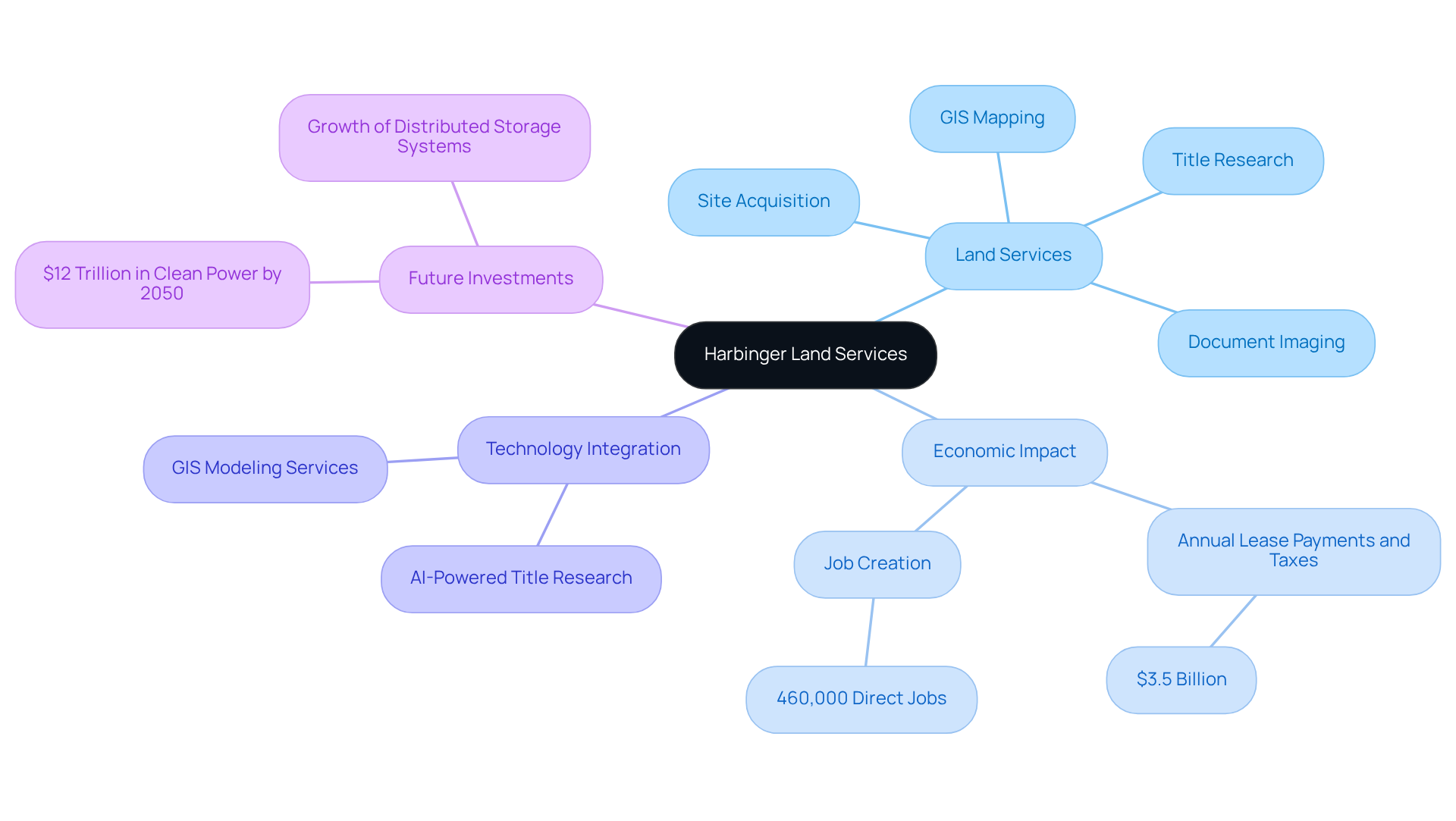
Environmental Sustainability: Reducing Carbon Footprint with Small-Scale Storage
Small-scale distributed storage systems play a crucial role in mitigating the carbon footprint associated with energy consumption. Small-scale distributed storage systems capture and store surplus energy generated from renewable sources such as solar and wind, significantly reducing reliance on fossil fuels. This transformation not only lowers greenhouse gas emissions but also enhances resource efficiency.
For example, during peak power generation periods, excess energy can be stored for future use, effectively balancing supply and demand. Such practices diminish dependence on carbon-intensive backup power options, illustrating how retaining renewable resources can lead to substantial reductions in greenhouse gas emissions.
Recent data indicates that small-scale distributed storage systems integrated as retention solutions can yield significant emission reductions, underscoring their importance in the transition toward a sustainable energy future.
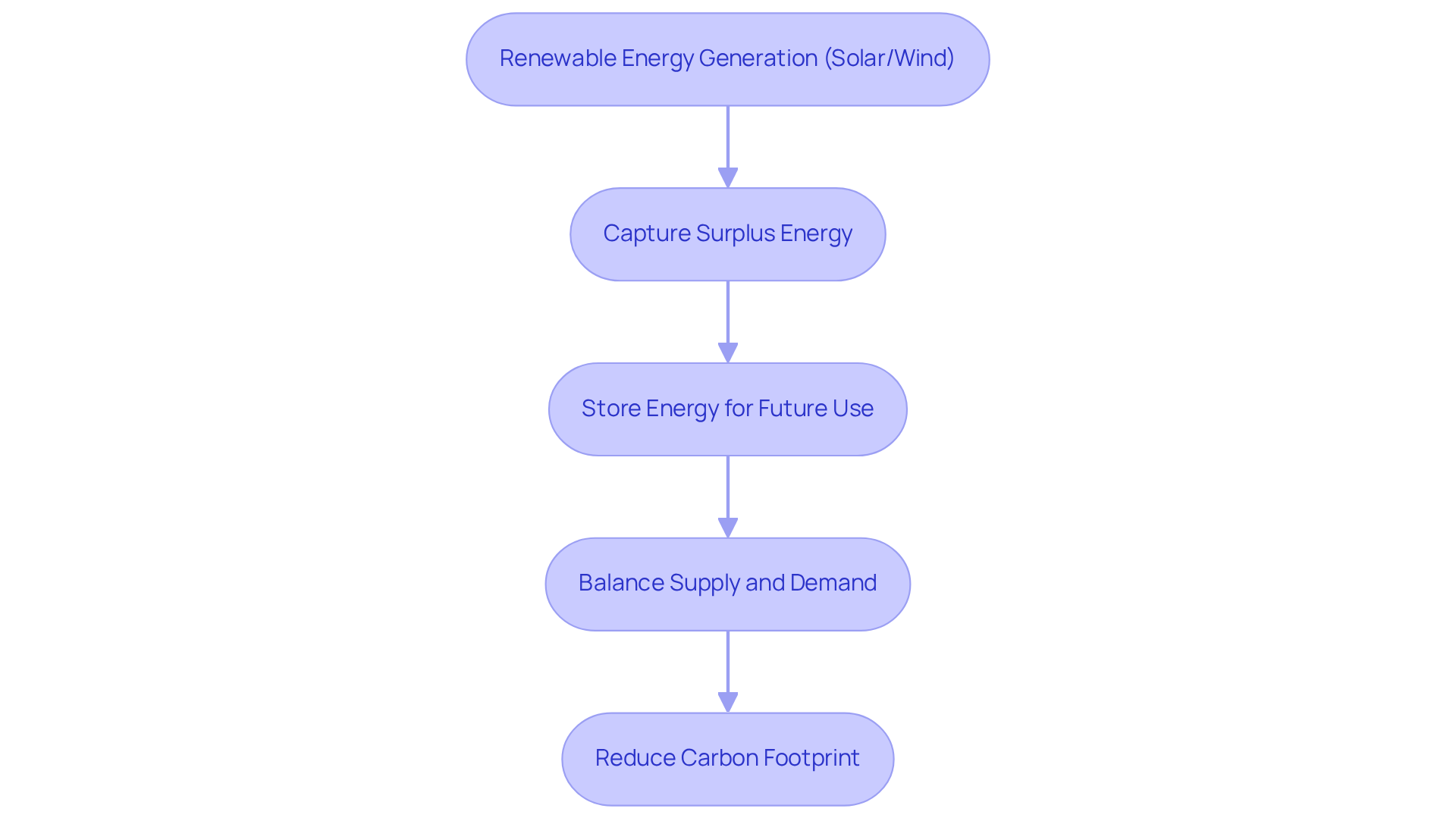
Cost Efficiency: Lowering Energy Expenses through Distributed Storage Solutions
Small-scale distributed storage systems play a pivotal role in reducing expenses, enabling users to save power during off-peak hours when prices are lower and utilize it during peak demand periods when costs escalate. This strategy, known as peak shaving, can lead to substantial savings on electricity bills. For instance, companies that adopt battery storage solutions have reported annual savings in the thousands by optimizing their consumption patterns. Moreover, by decreasing the need for costly grid enhancements and fostering autonomy in power, both businesses and residents can enjoy sustainable long-term financial benefits.
Studies indicate that small-scale distributed storage systems can reduce power expenses by as much as 20-30%, making them an attractive option for individuals looking to enhance their power management strategies. Furthermore, decentralized data management contributes to environmental improvements by reducing dependence on centralized energy plants, which in turn lowers particulate matter and nitrogen oxide concentrations. As highlighted by the Observer, power retention through decentralized sources can cultivate a sense of independence and collective empowerment, further emphasizing the importance of these networks in rural communities.
To effectively implement distributed resource solutions, companies and residents should consider:
- Conducting feasibility assessments
- Collaborating with local stakeholders to align their strategies with community needs
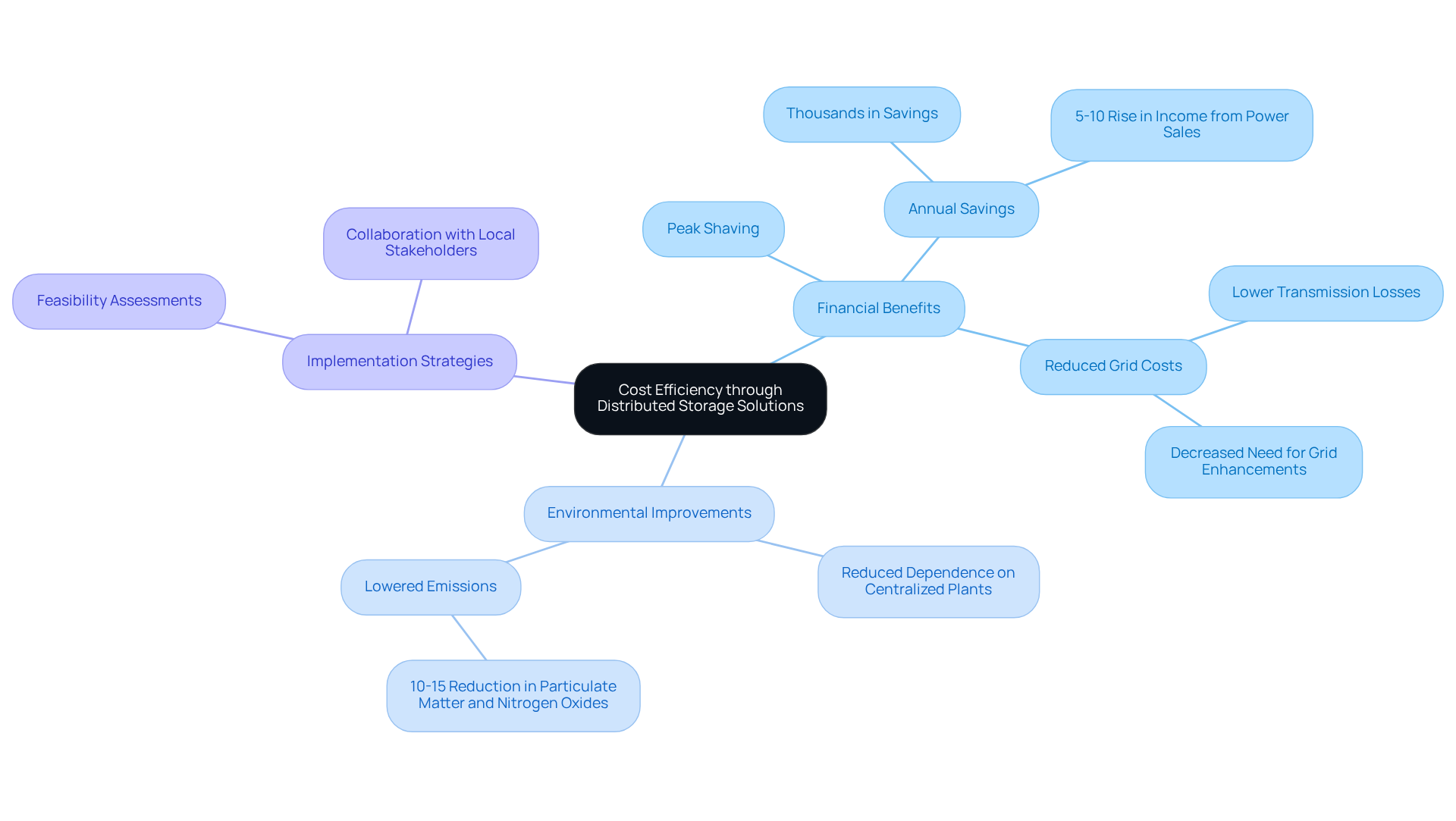
Enhanced Reliability: Improving Energy Security with Distributed Storage Systems
Distributed networks significantly enhance power security by providing reliable backup electricity during outages and stabilizing the grid amid fluctuations in supply and demand. By distributing energy reserves, these systems mitigate the risk of widespread outages, thereby strengthening the resilience of the energy framework. Consider Hurricane Ian in September 2022, when over 2.6 million customers in Florida experienced prolonged power outages, underscoring the urgent need for localized storage solutions. Such frameworks ensure that essential services remain operational during severe weather events, protecting communities and businesses from disruptions.
In 2022, U.S. electricity customers faced an average of five and one-half hours of interruptions, nearly two hours less than in 2021, which highlights the critical importance of backup power reliability. The System Average Interruption Duration Index (SAIDI) and the System Average Interruption Frequency Index (SAIFI) serve as key metrics for measuring the duration and frequency of power interruptions, respectively, offering valuable insights into power reliability.
As we approach 2025, the integration of small-scale distributed storage systems will be essential in addressing these challenges, providing a robust safety net for power users and enhancing overall grid stability. As Alex Gorski noted, 'On average, U.S. electricity customers encountered about five and a half hours of power outages in 2022, nearly two hours fewer than in 2021,' emphasizing the effectiveness of these frameworks in bolstering supply security.
Furthermore, for Directors of Land Acquisition, understanding the role of small-scale distributed storage systems can significantly influence strategies for power projects, particularly in regions vulnerable to outages. How can your organization leverage this knowledge to improve project outcomes? The time to act is now.
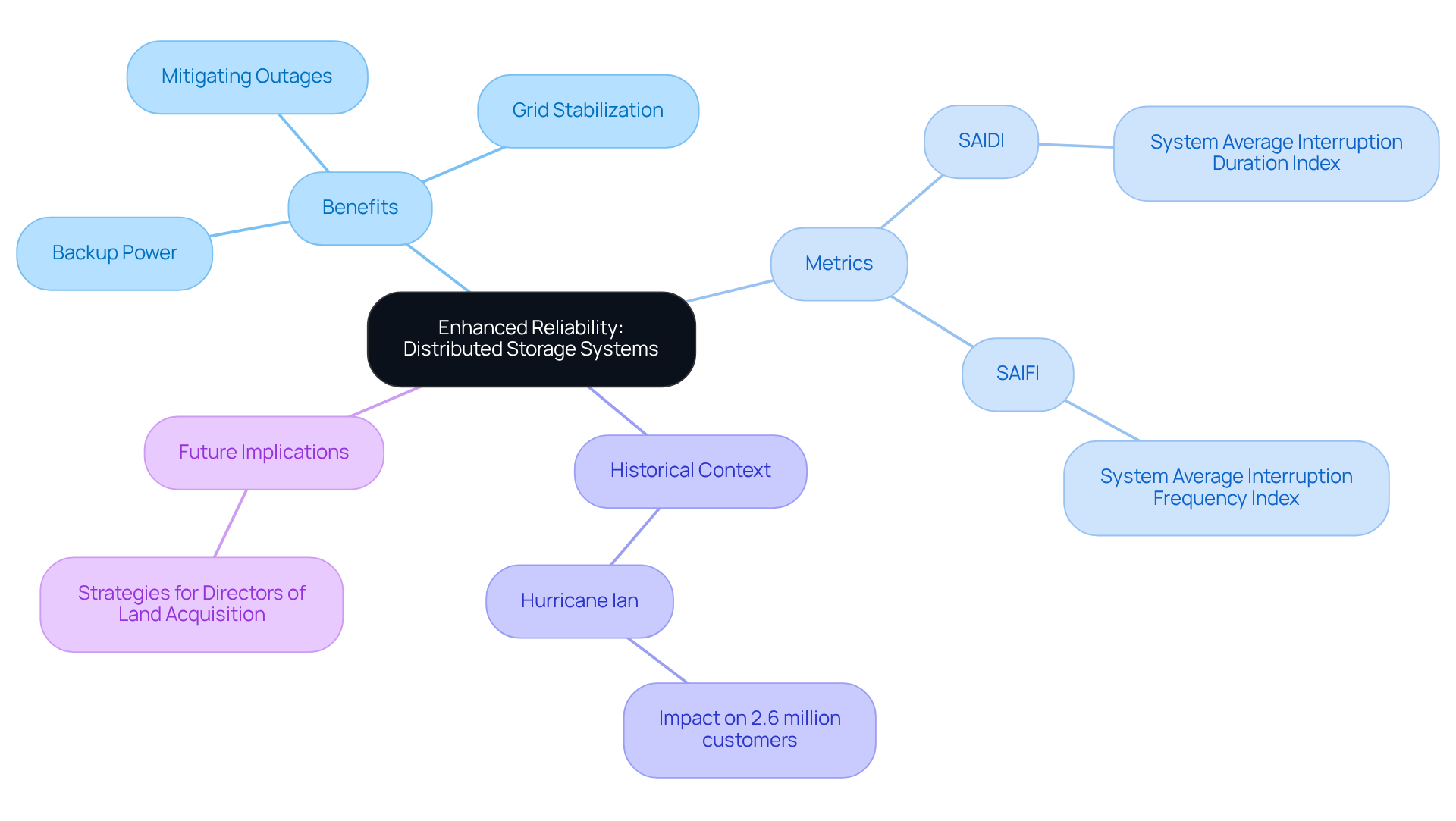
Renewable Energy Integration: Facilitating the Use of Clean Energy Sources
Distributed storage networks are essential for integrating renewable power sources into the grid, addressing the inherent variability of generation from sources such as solar and wind. By capturing surplus power generated during peak production periods, these systems ensure a more reliable and consistent supply. This capability not only maximizes the utilization of renewable resources but also significantly reduces dependence on fossil fuels. Consider this: during periods of heightened solar or wind production, excess power can be stored for future use, effectively smoothing out fluctuations and enhancing the overall sustainability of the power system.
Looking ahead to 2025, the impact of power retention on sustainable resource utilization is expected to be profound. Forecasts indicate that retention will constitute a substantial portion of new capacity expansions. As solar installations continue to grow, with solar accounting for over 69% of new capacity in Q1 2025, the integration of retention solutions will be vital for ensuring supply reliability and facilitating the transition to a cleaner energy landscape. How prepared are we to embrace these advancements and their implications for our energy future?
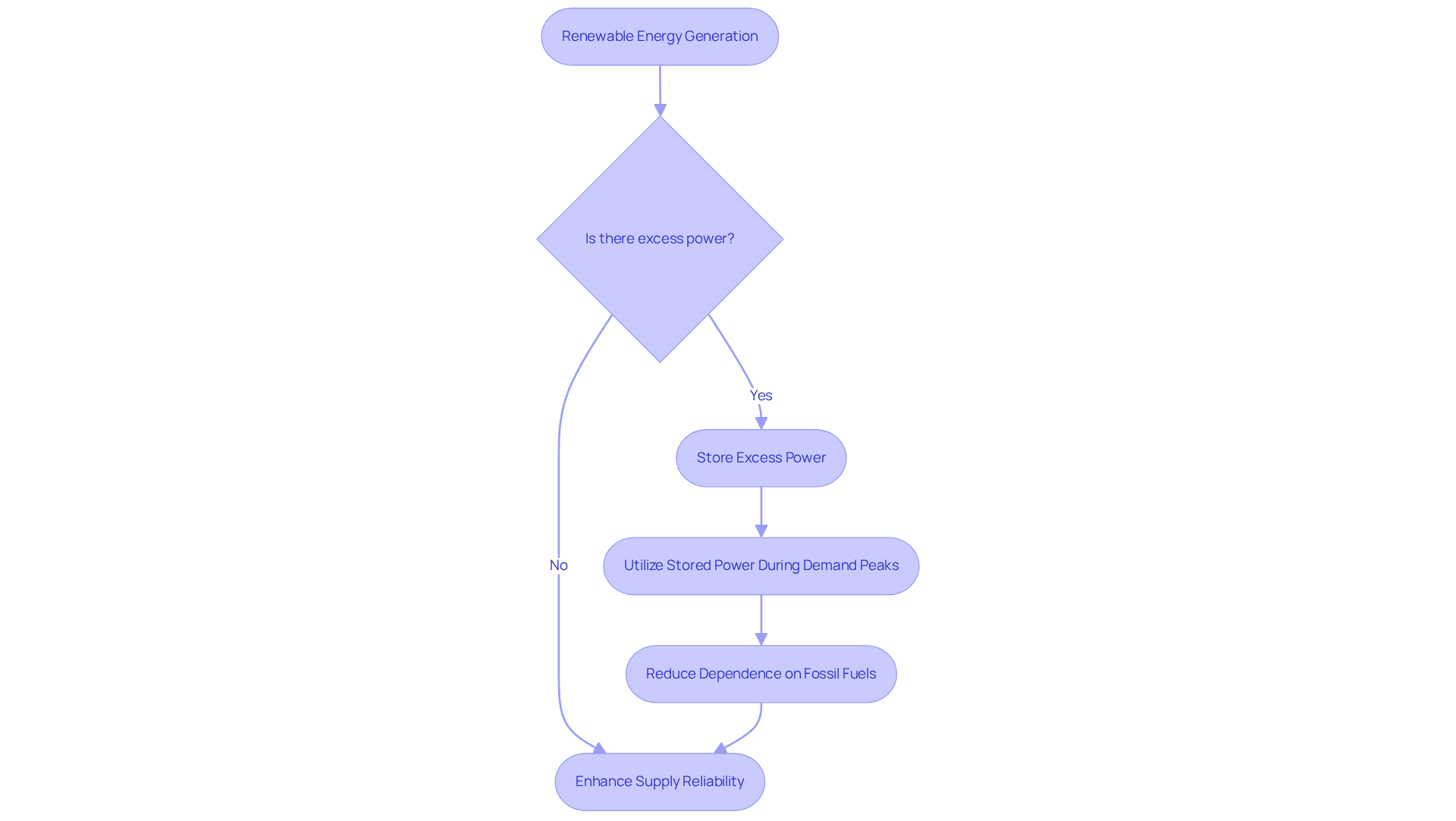
Operational Flexibility: Adapting to Dynamic Energy Needs with Distributed Storage
Distributed storage systems significantly enhance operational flexibility, enabling consumers to adapt their usage patterns in response to real-time availability and pricing. This adaptability is essential in an environment where power demand can fluctuate dramatically. For example, companies can strategically shift their power consumption to off-peak times when electricity rates are lower, utilizing stored power during peak demand periods to minimize expenses. This dynamic response capability not only optimizes power consumption but also fortifies the resilience and efficiency of the power grid.
Looking ahead to 2025, real-time pricing mechanisms for resources are expected to further incentivize this behavior, allowing users to capitalize on cost variations. As industry specialists have noted, adjusting power usage patterns in real-time is not just a trend; it is increasingly becoming a necessity for companies aiming to thrive in a competitive landscape while contributing to a sustainable energy future. Are you prepared to embrace this shift in power consumption strategy?
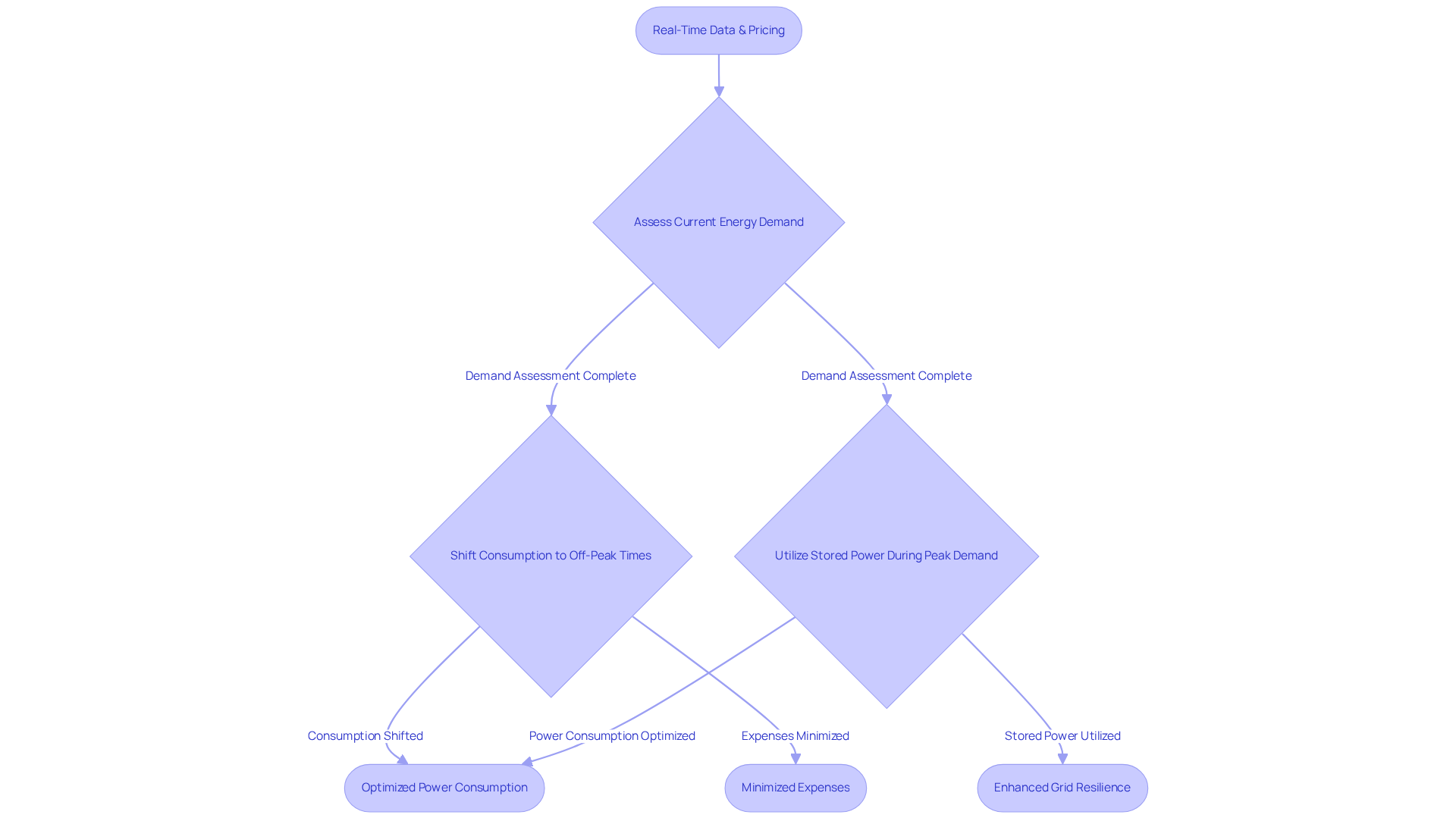
Community Empowerment: Supporting Local Economies with Distributed Storage Solutions
Distributed solutions are pivotal in empowering communities by fostering local power independence and stimulating economic growth. By investing in these projects, communities can assert control over their power supply, mitigating vulnerability to external market fluctuations and bolstering resilience against power crises. Notably, shared resource projects have the potential to create substantial employment opportunities, as they often involve local residents in the planning, installation, and maintenance of power systems.
For instance, community solar initiatives, when paired with decentralized reserves, not only provide cost-effective energy options but also invigorate local economies through job creation. Looking ahead to 2025, the economic advancement potential of these initiatives is expected to rise, with community power retention projects projected to generate thousands of jobs nationwide, further underscoring their critical role in the transition to sustainable energy solutions.
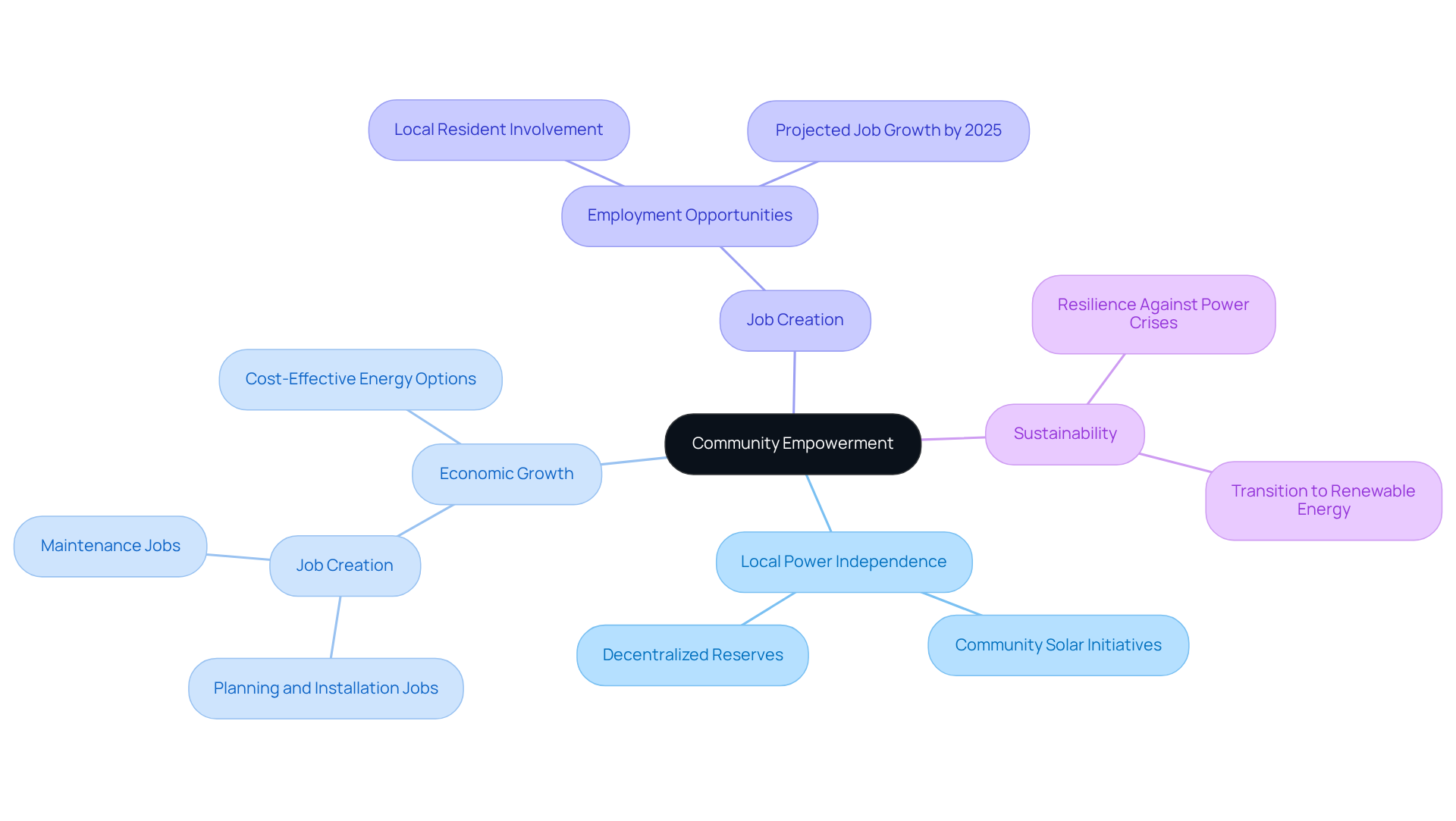
Technological Innovation: Advancements in Small-Scale Distributed Storage Systems
Recent advancements in small-scale distributed storage systems have markedly improved their efficiency, capacity, and affordability. Innovations such as solid-state batteries and advanced management systems are transforming power retention and usage.
- Solid-state batteries, promising greater power density and safety, are poised to revolutionize capacity solutions by 2025.
- Furthermore, the integration of smart grid technologies facilitates real-time resource management, enhancing performance and reducing operational expenses.
- Notably, lithium-ion battery pack costs have decreased from over $780 per kilowatt-hour (kWh) in 2013 to $139 per kWh in 2023, representing an 82% decline. This significant reduction makes power solutions more accessible across various sectors.
These advancements in small-scale distributed storage systems not only improve the efficiency of storage options but also foster wider acceptance, enabling consumers and businesses to utilize renewable resources more effectively. As Elon Musk stated, "We know we’ll exhaust our supply of fossil fuels for mining and have to utilize sustainable resources eventually, so why not adopt renewables now and avoid increasing the risk of climate catastrophe?
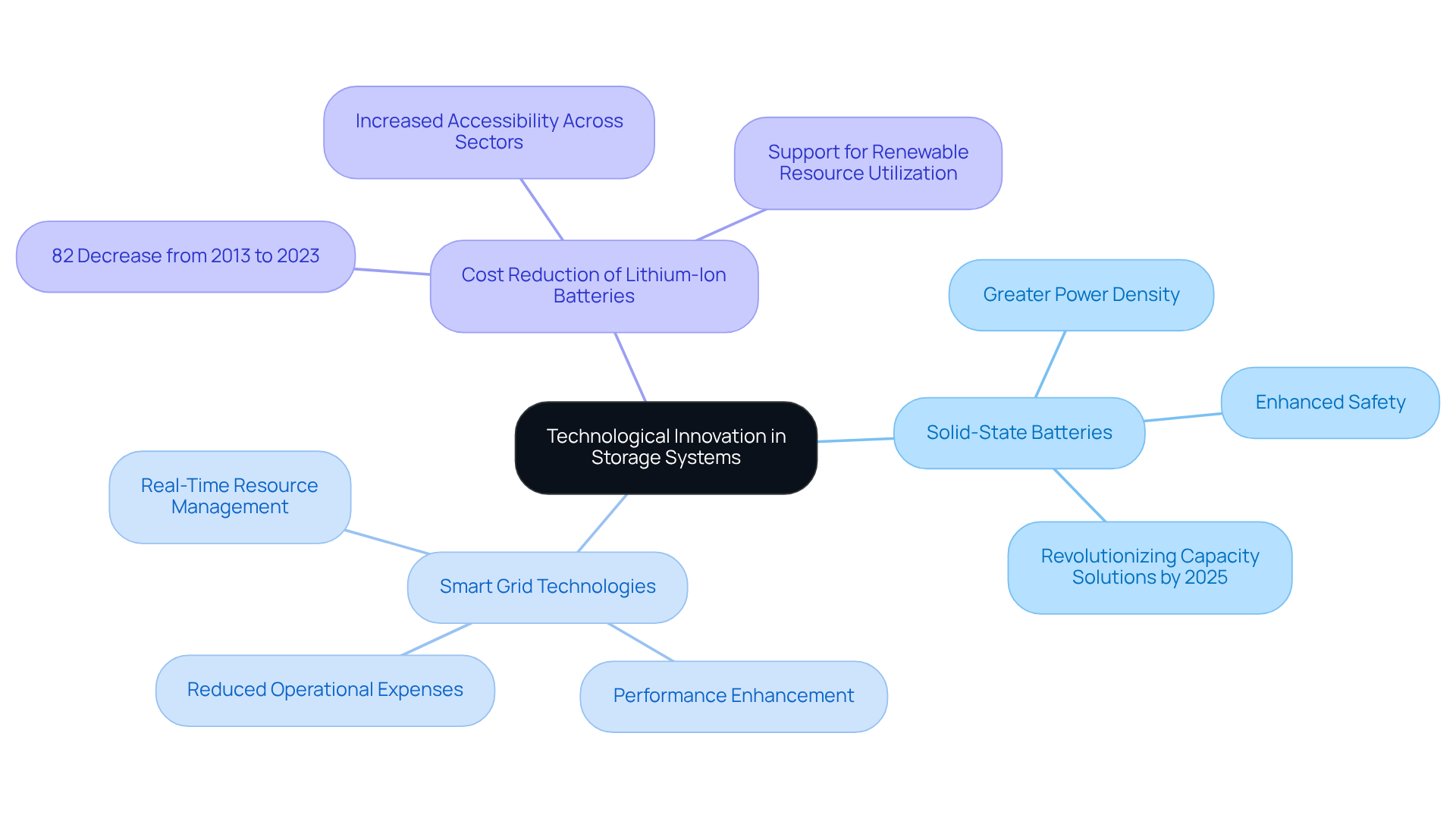
Regulatory Compliance: Navigating Energy Policies with Distributed Storage Systems
Navigating the regulatory landscape is crucial for the successful implementation of small-scale distributed storage systems. Adherence to local, state, and federal regulations ensures that power reserve initiatives meet safety, environmental, and operational standards. Stakeholders must remain vigilant regarding evolving regulations that impact power retention, including incentives for renewable resource integration and grid connection requirements. Understanding the complexities of Federal Energy Regulatory Commission (FERC) regulations can empower project developers to enhance their capacity solutions while ensuring compliance with national standards.
As California anticipates a need for 52,000 MW of battery capacity by 2045, with its installed battery capacity now exceeding 20% of the state's peak demand, staying informed about these regulations is essential for maximizing the potential of small-scale distributed storage systems and for aligning with the state's clean energy objectives. Additionally, with 33% of respondents expecting their compliance teams to expand in the coming year, the emphasis on regulatory vigilance is more critical than ever.
Alice Reynolds, President of the California Public Utilities Commission, underscores the importance of safety in battery management, stating, "We have to be very, very aware of the safety risk." This highlights the necessity for stakeholders to prioritize compliance and safety in their power reserve initiatives. The call to action is clear: stakeholders must engage with regulatory updates proactively to ensure the success and safety of their projects.
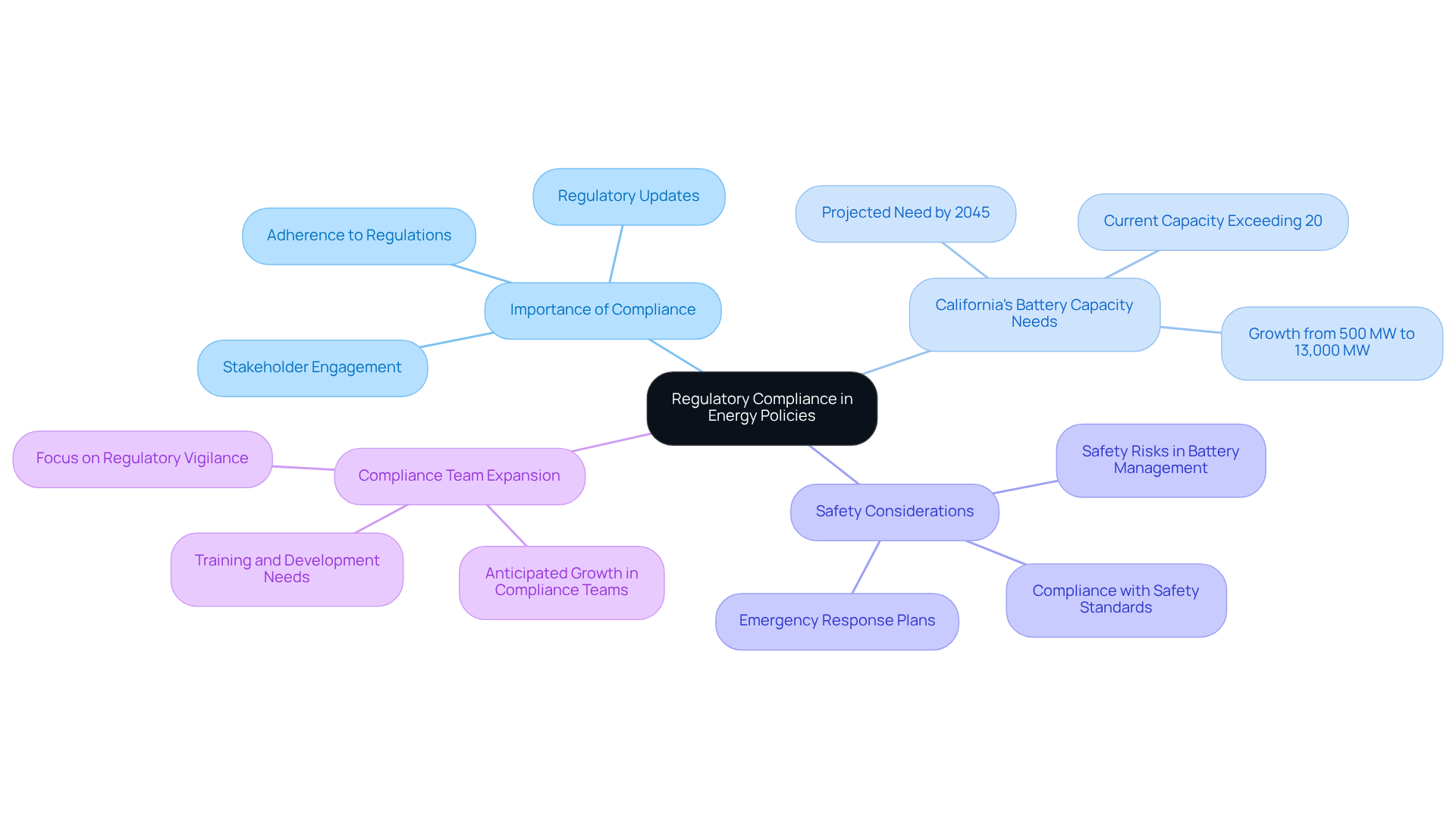
Transformative Impact: The Role of Small-Scale Distributed Storage in Modern Energy Systems
Small-scale distributed storage systems are set to revolutionize contemporary power networks. They enhance efficiency and facilitate the integration of renewable resources, providing reliable backup power—an essential component for achieving a sustainable energy future. As technology advances and regulatory frameworks evolve, communities and businesses will gain greater control over their energy needs. This shift towards decentralized power solutions not only aligns with environmental objectives but also bolsters economic resilience and fosters energy independence.
Notably, the implementation of decentralized data management has been linked to:
- A 20-30% increase in household electrification rates
- A 5-10% rise in annual income from power sales
- A 1-2% increase in property tax revenue for rural electric cooperatives
These statistics underscore the transformative impact on efficiency and local economies. By enabling rural areas to harness renewable resources effectively, small-scale distributed storage systems play a pivotal role in creating a sustainable and resilient energy landscape.
Engaging stakeholders early in the planning process is crucial for enhancing project acceptance and support, further reinforcing the advantages of these decentralized energy solutions. Harbinger Land's expertise in facilitating partnerships and securing easements is vital for navigating funding challenges, ensuring the successful execution of distributed storage projects.
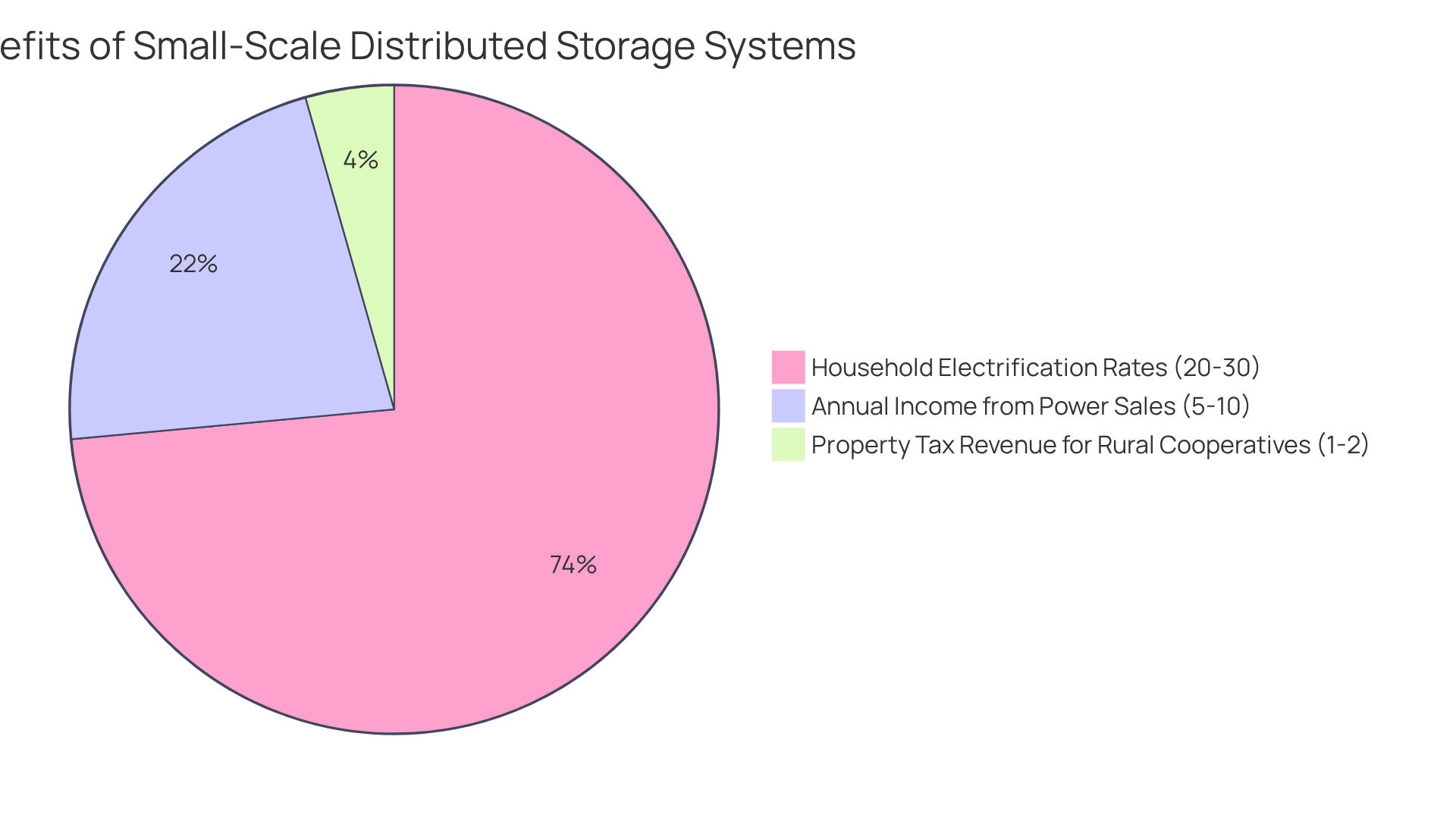
Conclusion
Small-scale distributed storage systems are revolutionizing the energy landscape by delivering a range of benefits that boost efficiency, reliability, and sustainability. These systems are essential for integrating renewable energy sources, minimizing carbon footprints, and empowering local communities. As the demand for clean and dependable energy solutions escalates, the importance of these storage systems becomes increasingly apparent, showcasing their potential to transform energy consumption patterns and enhance economic resilience.
Key insights have emerged throughout this discussion, including:
- The cost savings realized through peak shaving
- The increased energy security during outages
- The operational flexibility that enables consumers to respond to changing energy needs
The impact of technological advancements on enhancing the efficiency and affordability of these systems is also significant. Innovations in battery technology and smart grid integration have illuminated the path toward a sustainable energy future.
The call to action is unequivocal: stakeholders must prioritize the adoption and implementation of small-scale distributed storage systems to harness their myriad advantages. By engaging in community-driven initiatives, remaining informed about regulatory developments, and leveraging technological innovations, individuals and organizations can play a pivotal role in fostering a more sustainable, resilient, and empowered energy future. Embracing these transformative solutions is not merely an opportunity; it is essential for achieving enduring change in the energy sector.
Frequently Asked Questions
What services does Harbinger Land provide?
Harbinger Land offers comprehensive land services tailored for infrastructure projects, including site and right-of-way acquisition, title research, GIS mapping, and advanced data processing solutions.
How does Harbinger Land enhance efficiency in land services?
Harbinger Land utilizes highly integrated GIS modeling services and AI-powered title research software to significantly improve efficiency and client satisfaction, ensuring timely and precise services.
Why is effective land acquisition becoming more critical as we approach 2025?
The need for effective land acquisition solutions is increasing due to the growing importance of small-scale distributed storage systems, which support the implementation and functioning of energy projects.
What economic impact do wind and solar projects have in terms of land management?
Wind and solar projects generate approximately $3.5 billion annually in landowner lease payments and taxes, highlighting the economic significance of effective land management.
How does Harbinger Land contribute to environmental sustainability?
Harbinger Land digitizes property data through efficient document imaging solutions, enabling title agents to perform title research and leasing in a cost-effective manner, which supports sustainable land use practices.
What role do small-scale distributed storage systems play in reducing carbon footprint?
Small-scale distributed storage systems capture and store surplus energy from renewable sources, reducing reliance on fossil fuels, lowering greenhouse gas emissions, and enhancing resource efficiency.
How do small-scale distributed storage systems help in balancing energy supply and demand?
These systems store excess energy generated during peak production times for future use, which helps balance supply and demand and diminishes dependence on carbon-intensive backup power.
What financial benefits do small-scale distributed storage systems offer?
They enable users to save energy during off-peak hours and use it during peak periods, leading to substantial savings on electricity bills, with reductions in power expenses by as much as 20-30%.
How do small-scale distributed storage systems contribute to environmental improvements?
By reducing dependence on centralized energy plants, they lower particulate matter and nitrogen oxide concentrations, contributing to better air quality and overall environmental health.
What steps should companies and residents take to implement distributed resource solutions effectively?
They should conduct feasibility assessments and collaborate with local stakeholders to align their strategies with community needs.
List of Sources
- Harbinger Land | Comprehensive Solutions for Land Services in Energy and Infrastructure
- The Latest Statistics & Trends on U.S. Clean Energy (https://acore.org/resources/the-latest-statistics-trends-on-u-s-clean-energy)
- Optimizing Energy Projects: Land Acquisition and Consulting for Sustainable Development (https://blog.harbingerland.com/optimizing-energy-projects-land-acquisition-and-consulting-for-sustainable-development)
- Clean Power Facts | ACP (https://cleanpower.org/facts)
- 20 Quotes To Get You Inspired For a Renewable Future - Solstice (https://solstice.us/solstice-blog/20-quotes-for-a-renewable-future)
- 60 Quotes About the Future of Renewable Energy (https://deliberatedirections.com/renewable-energy-quotes)
- Environmental Sustainability: Reducing Carbon Footprint with Small-Scale Storage
- Thought Leaders (https://carbontax.org/thought-leaders)
- 60 Quotes About the Future of Renewable Energy (https://deliberatedirections.com/renewable-energy-quotes)
- 20 Quotes To Get You Inspired For a Renewable Future - Solstice (https://solstice.us/solstice-blog/20-quotes-for-a-renewable-future)
- Quotes About Solar Power: 50 Picks to Light Up Your Life - Lumify Energy (https://lumifyenergy.com/blog/quotes-about-solar-power)
- Cost Efficiency: Lowering Energy Expenses through Distributed Storage Solutions
- 4 Key Strategies for Distributed Storage for Rural Areas (https://blog.harbingerland.com/4-key-strategies-for-distributed-storage-for-rural-areas)
- Enhanced Reliability: Improving Energy Security with Distributed Storage Systems
- U.S. electricity customers averaged five and one-half hours of power interruptions in 2022 - U.S. Energy Information Administration (EIA) (https://eia.gov/todayinenergy/detail.php?id=61303)
- Renewable Energy Integration: Facilitating the Use of Clean Energy Sources
- 20 Quotes To Get You Inspired For a Renewable Future - Solstice (https://solstice.us/solstice-blog/20-quotes-for-a-renewable-future)
- 60 Quotes About the Future of Renewable Energy (https://deliberatedirections.com/renewable-energy-quotes)
- Solar Industry Research Data – SEIA (https://seia.org/research-resources/solar-industry-research-data)
- 2025 Renewable Energy Industry Outlook (https://deloitte.com/us/en/insights/industry/renewable-energy/renewable-energy-industry-outlook.html)
- Statistics Explained (https://ec.europa.eu/eurostat/statistics-explained/index.php/Renewable_energy_statistics)
- Operational Flexibility: Adapting to Dynamic Energy Needs with Distributed Storage
- Assessing the Flexibility Potential of Small-Scale Distributed Battery Storage Systems Under Distribution Network Constraints: A Case Study for Germany | Proceedings of the 16th ACM International Conference on Future and Sustainable Energy Systems (https://dl.acm.org/doi/10.1145/3679240.3734625)
- 60 Quotes About the Future of Renewable Energy (https://deliberatedirections.com/renewable-energy-quotes)
- Executive summary – Unlocking the Potential of Distributed Energy Resources – Analysis - IEA (https://iea.org/reports/unlocking-the-potential-of-distributed-energy-resources/executive-summary)
- 20 Quotes To Get You Inspired For a Renewable Future - Solstice (https://solstice.us/solstice-blog/20-quotes-for-a-renewable-future)
- Community Empowerment: Supporting Local Economies with Distributed Storage Solutions
- Inspiring Solar Energy Quotes: Motivation for a Sustainable Future (https://blog.feniceenergy.com/inspiring-solar-energy-quotes-motivation-for-a-sustainable-future)
- The Executive Headlines - Top business magazine & news headlines sources (https://executiveheadlines.com/erp/quotes-on-sustainable-energy)
- 100+ inspirational and powerful quotes on Sustainability (clustered by topic) - Twenty Now (https://twentynow.com/sustainability-initiatives/sustainability/100-inspirational-and-powerful-quotes-on-sustainability-clustered-by-topic)
- Technological Innovation: Advancements in Small-Scale Distributed Storage Systems
- Clean Energy Storage Facts | ACP (https://cleanpower.org/facts/clean-energy-storage)
- 60 Quotes About the Future of Renewable Energy (https://deliberatedirections.com/renewable-energy-quotes)
- The Executive Headlines - Top business magazine & news headlines sources (https://executiveheadlines.com/erp/quotes-on-sustainable-energy)
- 100+ Solar Panel Quotes to Inspire Your Green Energy Journey (https://aigift.alibaba.com/quotes/solar-panel-quotes)
- Regulatory Compliance: Navigating Energy Policies with Distributed Storage Systems
- Case Studies Archive - Sustainable Solutions | CAMS | Energy Optimized (https://camstex.com/case_studies)
- Empowering the Future: The Most Inspirational Quotes About Battery Energy Storage (https://eszoneo.com/info-detail/empowering-the-future-the-most-inspirational-quotes-about-battery-energy-storage)
- The Top 10 Quotes on Energy So Far in 2013 (https://greentechmedia.com/articles/read/the-top-10-quotes-on-energy-so-far-in-2013)
- 110 Compliance Statistics to Know for 2025 (https://secureframe.com/blog/compliance-statistics)
- California PUC approves battery storage safety rules (https://utilitydive.com/news/california-puc-approves-battery-storage-safety-rules/742644)
- Transformative Impact: The Role of Small-Scale Distributed Storage in Modern Energy Systems
- The Top 10 Quotes on Energy So Far in 2013 (https://greentechmedia.com/articles/read/the-top-10-quotes-on-energy-so-far-in-2013)
- 4 Key Strategies for Distributed Storage for Rural Areas (https://blog.harbingerland.com/4-key-strategies-for-distributed-storage-for-rural-areas)




